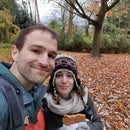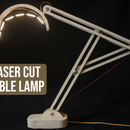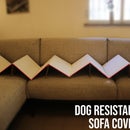Introduction: Dye Stained Tear-Off Daily Planner / To-Do List (DIY Binding)
I know! It looks like I spilled ocean all over my paper! In a minute I'll show you how you can make your own if you like :)
In this instructable I'll show you how to make your own dye-stained tear-off daily planner / to-do list. You can generalize what I'm going to show you in order to make notebooks and whatever you like.
In the first part, I'll try to teach you how to bind your own tear-off daily planners / to-do lists. In the second part I'll show you how I use water-based dyes (acrylic paint) to get that ocean-beach look!
Hope you like it!
** Young people may need help with some of the steps (using hot glue / an iron)!
Supplies
You'll need:
1) A black/white printer & some printer paper.
2) Hot glue.
3) A utility knife or scissors.
4) Acrylic paint.
5) An iron.
6) Wood clamps (optional, but preferred).
Step 1: Print & Slice!
Start off by printing your favorite to-do list / daily planner template. I've attached some that I made (and used in this instructable). Make sure that you approve of its final size before printing many copies. Once you've decided on a template and printed a test to make sure it's good for you, print about 40-50 copies of the template. I tried to squeeze in more than one in each page I printed to save on paper.
Next, cut the templates and stack them together.
Attachments
Step 2: Stack Them All!
Place all of the sliced templates on top of each other. Make sure they're all neatly lined up.
As an optional step, you could add a piece of hard cardboard to the stack you've made like I did.
Next, use two pieces of plywood / metal / anything else that's flat, and some clamps to hold the stack tight. Make sure that the stack of paper and the plywood pieces are flush.
Step 3: Time for Hot Glue!
Apply hot glue to the top of your stack. Use a popsicle stick or something similar to smooth it out and spread it evenly.
The next part is optional but highly recommended:
Turn on the iron and place it on a flat surface. You're going to iron the hot glue in order to make it thinner and smoother. Since I wanted to avoid ironing the glue directly with the iron itself, I placed a piece of metal (a hand-saw in my case) and held it against the hot iron. Now squish the top of your stack (where the hot glue is) against the hot metal. You should end up with a thin, shiny surface of hot glue (see images). This makes the papers hold better and also easier to tear off (compare the 2nd and 5th images to see the difference).
Step 4: It's Time for Paint!
Next, we'll be soaking our to-do list in paint! This will give it the ocean-dipped look :)
I used blue, but you can use anything you like!
Dilute your paint in tap water. This is a bit tricky - the more color you add, the more intense the color will end up - which is a good thing! On the other hand, more paint means that the paper will not soak the paint properly (that's why we dilute it). Plus, using too much paint could make your pages stick together while it drys! This is more of a trial & error but a good place to start is diluting the paint to about 1:10.
Dip the stack of paper you made in the diluted dye for a few seconds (3-5 seconds would be more than enough). Pull it out, let it drip and soak some of the remaining paint using a paper towel.
Step 5: Flatten the Paper (Optional)
When paper dries, it often gets lots of wrinkles and 'waves' all over. I liked how it turned out since it adds to the ocean look, but I figured some people might want it flat.
After you've whipped off the excess liquids, take two pieces of flat surface (I used thin plywood) and place the stack of paper between them. Use wood clamps and press the surfaces tightly in order to flatten the paper. If you don't have clamps, you can use something heavy to press down on it (somehow the heaviest book I got talks about gravity!).
If you let the paper stay clamped for too long, chances are that the pages will stick together. Once in a while you should open the clamps and separate the pages. Do this with care since the pages are very fragile while wet! I blew air using an ordinary fan to dry the pages faster. You should do this about 30-60 minutes after your first clamping, and then 1-2 time later that day. Each time you do it, the paint will be drier and drier and the pages will be easier to separate.
Finally, when the paper is about 80% dry, you can leave it pressed over-night.
Step 6: Done!
Once it's completely dry, you're all done! Make sure the pages are well separated and enjoy your new ocean-stained daily schedule (or whatever you've decided to make!)





